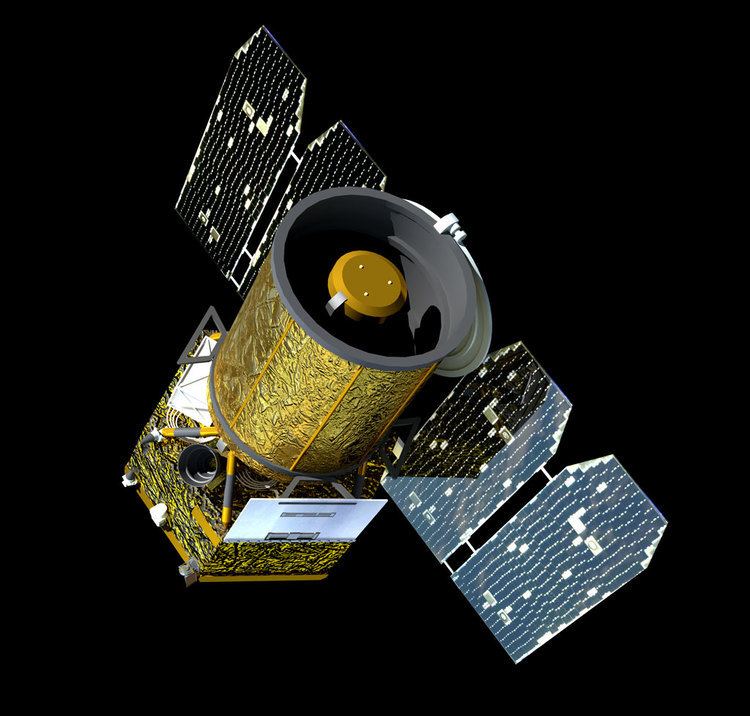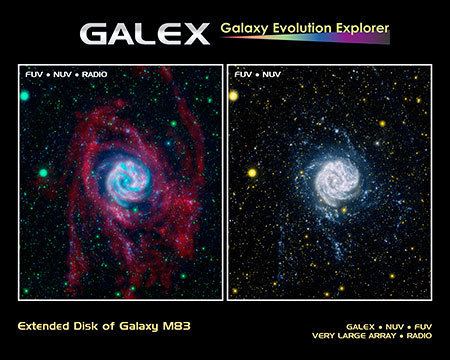Names Explorer-83, SMEX-7 SATCAT no. 27783 Max speed 27,000 km/h Rocket Pegasus | COSPAR ID 2003-017A Launch date 28 April 2003 Speed on orbit 7.5 km/s Cost 150.6 million USD (2011) | |
 | ||
Similar IRAS, Spitzer Space Telescope, Chandra X‑ray Observatory, Wide‑field Infrared Survey E, International Ultraviolet Explorer | ||
Mission update galex
The Galaxy Evolution Explorer (GALEX) is an orbiting ultraviolet space telescope launched on April 28, 2003, and operated until early 2012.
Contents

Galex mission log
History

An airlaunched Pegasus rocket placed the craft into a nearly circular orbit at an altitude of 697 kilometres (433 mi) and an inclination to the Earth's equator of 29 degrees.

The first observation was dedicated to the crew of the Space Shuttle Columbia, being images in the constellation Hercules taken on May 21, 2003. This region was selected because it had been directly overhead the shuttle at the time of its last contact with the NASA Mission Control Center.

After its primary mission of 29 months, observation operations were extended to almost 9 years with NASA placing it into standby mode on 7 Feb 2012.

NASA cut off financial support for operations of GALEX in early February 2011 as it was ranked lower than other projects which were seeking a limited supply of funding. The mission's life-cycle cost to NASA was $150.6 million. The California Institute of Technology negotiated to transfer control of GALEX and its associated ground control equipment to the California Institute of Technology in keeping with the Stevenson-Wydler Technology Innovation Act. Under this Act, excess research equipment owned by the US government can be transferred to educational institutions and non-profit organizations. In May 2012, GALEX operations were transferred to Caltech.

A fund-raising effort called GALEX CAUSE is being run to try and complete its All-Sky UV Survey. Its unique ultraviolet observations shed new light on special studies of galaxies, black-holes, supernova, stars, and beyond.
On June 28, 2013 NASA decommissioned GALEX. It is expected that the spacecraft will remain in orbit for at least 65 years before it will re-enter the atmosphere.
Science mission
During its initial 29-month mission, which was extended, it made observations in ultraviolet wavelengths to measure the history of star formation in the universe 80 percent of the way back to the Big Bang. Since scientists believe the Universe to be about 13.8 billion years old, the mission will study galaxies and stars across about 10 billion years of cosmic history.
The spacecraft's mission is to observe hundreds of thousands of galaxies, with the goal of determining the distance of each galaxy from Earth and the rate of star formation in each galaxy. Near- and far-UV emissions as measured by GALEX can indicate the presence of young stars, but may also originate from old stellar populations (e.g. sdB stars).
Partnering with the NASA Jet Propulsion Laboratory (JPL) on the mission are the California Institute of Technology, Orbital Sciences Corporation, University of California, Berkeley, Yonsei University, Johns Hopkins University, Columbia University, and Laboratoire d'Astrophysique de Marseille, France.
The observatory participated in GOALS with Spitzer, Chandra, and Hubble. GOALS stands for Great Observatories All-sky LIRG Survey, and Luminous Infrared Galaxies were studied at the multiple wavelengths allowed by the telescopes.
Specifications
The telescope has a 50 cm diameter aperture primary, in a Richey-Chretien f/6 configuration. It can see light wavelengths from 135 nanometers to 280 nm, with a field of view of 1.2 degrees wide (larger than a full moon). It has gallium-arsenide solar cells which supply nearly 300 watts to the spacecraft.
